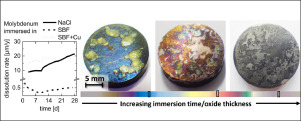当前位置:
X-MOL 学术
›
Acta Biomater.
›
论文详情
Our official English website, www.x-mol.net, welcomes your
feedback! (Note: you will need to create a separate account there.)
Molybdenum - A biodegradable implant material for structural applications?
Acta Biomaterialia ( IF 9.4 ) Pub Date : 2020-01-09 , DOI: 10.1016/j.actbio.2019.12.031 Christian Redlich 1 , Peter Quadbeck 1 , Michael Thieme 2 , Bernd Kieback 2
Acta Biomaterialia ( IF 9.4 ) Pub Date : 2020-01-09 , DOI: 10.1016/j.actbio.2019.12.031 Christian Redlich 1 , Peter Quadbeck 1 , Michael Thieme 2 , Bernd Kieback 2
Affiliation

|
Molybdenum as a potentially new biodegradable material was investigated. Degradation behavior of commercially high purity molybdenum was observed in simulated physiological salt solutions (Kokubo's SBF with/without TRIS-HCl, Cu2+ addition and 0.9% NaCl solution). Potentiodynamic polarization, immersion mass loss and ion concentration measurements paired with REM/EDX analysis reveal gradual dissolution of molybdenum in the proper order of magnitude for stent application, associated with formation of thin, non-passivating corrosion products. The underlying corrosion mechanism is discussed as well as a comparison to literature data. However, formation of calcium phosphates (CaP) in SBF significantly decreases corrosion rates. In-situ polarization was found to be a potential way for overcoming this problem and simultaneously enhancing corrosion above the benchmark for a degradable stent material. STATEMENT OF SIGNIFICANCE: Biodegradable metals have the potential to overcome severe complications common to orthopedic and cardio-vascular implants. However, the need for a material with moderate and predictable degradation, high strength and toughness as well as MRI suitability must be satisfied. Molybdenum as potential new biodegradable material may just fulfill these requirements. An overall positive picture of molybdenum as an interesting alternative to recently discussed metallic biodegradable materials can be concluded from the herein presented results and from literature data, showing directions for future research on the topic.
中文翻译:

钼-用于结构应用的可生物降解的植入材料?
研究了钼作为一种潜在的新型可生物降解材料。在模拟的生理盐溶液(Kokubo的SBF中添加/不添加TRIS-HCl,添加Cu2 +和0.9%NaCl溶液)中观察到了商业上高纯度钼的降解行为。电位动力学极化,浸没质量损失和离子浓度测量与REM / EDX分析相结合,揭示出钼以适当的数量级逐渐溶解以用于支架应用,并形成了薄的非钝化腐蚀产物。讨论了潜在的腐蚀机理以及与文献数据的比较。但是,在SBF中形成磷酸钙(CaP)会大大降低腐蚀速率。发现原位极化是克服该问题并同时将腐蚀增强到可降解支架材料的基准之上的潜在方法。意义声明:可生物降解的金属具有克服骨科和心血管植入物常见的严重并发症的潜力。但是,必须满足对中度和可预测的降解,高强度和韧性以及MRI适用性的要求。钼作为潜在的新型可生物降解材料可能仅满足这些要求。从本文介绍的结果和文献数据可以得出钼作为最近讨论的金属可生物降解材料的有趣替代品的总体正面印象,显示出该主题未来研究的方向。
更新日期:2020-01-09
中文翻译:

钼-用于结构应用的可生物降解的植入材料?
研究了钼作为一种潜在的新型可生物降解材料。在模拟的生理盐溶液(Kokubo的SBF中添加/不添加TRIS-HCl,添加Cu2 +和0.9%NaCl溶液)中观察到了商业上高纯度钼的降解行为。电位动力学极化,浸没质量损失和离子浓度测量与REM / EDX分析相结合,揭示出钼以适当的数量级逐渐溶解以用于支架应用,并形成了薄的非钝化腐蚀产物。讨论了潜在的腐蚀机理以及与文献数据的比较。但是,在SBF中形成磷酸钙(CaP)会大大降低腐蚀速率。发现原位极化是克服该问题并同时将腐蚀增强到可降解支架材料的基准之上的潜在方法。意义声明:可生物降解的金属具有克服骨科和心血管植入物常见的严重并发症的潜力。但是,必须满足对中度和可预测的降解,高强度和韧性以及MRI适用性的要求。钼作为潜在的新型可生物降解材料可能仅满足这些要求。从本文介绍的结果和文献数据可以得出钼作为最近讨论的金属可生物降解材料的有趣替代品的总体正面印象,显示出该主题未来研究的方向。











































 京公网安备 11010802027423号
京公网安备 11010802027423号